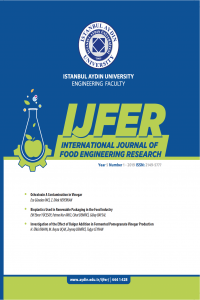Contamination of Dioxins in Foods
Contamination of Dioxins in Foods
Dioxin, , dioxin-like compounds, , human health, , toxicity , Dioxin analyzing techniques,
___
- [1] Arıkan, D., Yetim, H., Sağdıç, O., Kesmen, Z. 2009. Dioxin contamination in food and its effects on human health. Journal Of Food Technologies, 12, 9-15.
- [2] M. Van den Berg, L.S. Birnbaum, M. Denison, M. De Vito, W. Farland, M. Feeley, H. Fiedler, H. Hakansson, A. Hanberg, L. Haws, M. Rose, S. Safe, D. Schrenk, C. Tohyama, A. Tritscher, J. Tuomisto, M. Tysklind, N. Walker, R.E. Peterson, 2005 re-evaluation of human and mammalian genetic equivalence factors for dioxin and dioxinlike compounds of the World Health Organization, Toxicology. Science. 93 (2006) 223–241.
- [3] RN. Hoover. Dioxin dilemmas, J Natl Cancer Inst., 91:745-746, 1999.
- [4] G. Bröker, P. Bruckmann, H. Gliwa, Study of dioxin sources in North Rhine-Westphalia, Chemosphere, 38 (8): 1913-24, 1999.
- [5] Carcinogenic substances in chicken feed, (no date) http://www.ntvmsnbc.com/id/25167591/received from the address.
- [6] The additives used in products covered within the scope of this communiqué must be in compliance with Annex 1 of this communiqué and 2nd section of the “Turkish food Codex regulation”, 29.12.2011 date ve 28157 Number Official Gazette (no date) http://www.gkgm.gov.tr/mevzuat/kodeks/kodeks_ yonetmelik/bulasanlar_yonetmelik.htmlreceived from the address.
- [7] J. Tuomisto, T. Vartiainen and J.T. Tuomisto, Synopsis on Dioxins and PCBs, National Institute for Health and Welfare, (no date) http://www.thl.fi/thl-client/pdfs/81322e2c-e9b6- 4003-bb13-995dcd1b68cbreceived from the address.
- [8] P. Boffetta, K.A. Mundt, H.O. Adami, P. Cole, J.S. Mandel, TCDD and cancer: a critical review of epidemiologic studies, Crit. Rev.Toxicol., 41(7): 622-36, 2011.
- [9] F. Şahbaz, J. Acar. Dioxins and the Dioxin contamination possibility on Foods, Food, 18 (4) 243-245, 1993.
- [10] Dioksin Danger; Are the dioxins the most dangerous chemical in our environment? (no date) http://en.opasnet.org/w/Are_the_dioxins_ the_most_dangerous_chemicals_in_our_ environment%3Freceived from the address.
- [11] Yalçın, H., 2015. Dioxin and polyclinic biphenyls. Clinics In Turkey, J Food Hyg Technol – Special Topics., 1, 38-47.
- [12] O. Çiftçi, Investigation of dioxin and similar compound levels in the butter consumed in elazığ and its environments, Fırat UniversityJournal of Health Care, 22(5):289-292, 2008.
- [13] Lau, O. W. and Wongb, S. K. 2000. Contamination in food from packaging material. J. of Chromatography A, 882 (1-2), 255-270.
- [14] Hişmioğulları, Ş.E, Hişmioğulları, A.A., Aşkar, Kontaş, T. 2012. Toxic effects of dioxin and similar chemicals. Balıkesir Journal of Health Care, 1, 23-27.
- [15] Baytok, E., Bingöl, N.T. 2013. The toxins that enter our food table and our lives: dioxin. Journal of YYU Vet., 24, 45-49.
- [16] Vural H., 1995. Dioxin and furan isomers in terms of food pollution. Ecology Environment Derg., 15, 45-49.
- [17] Güneş G. 2007. Dioxin and furan formation mechanisms and removal technologies. Master’s Thesis. Yildiz Technical University, Graduate School Of Natural And Applied Sciences, Department Of Environmental Engineering. İstanbul.
- [18] Güler, Ü.A, Kundakçı, Ö. 2014. The effects of dioxin and similar compounds on human and environmental health, Karaelmas Journal of Science and Engineering, 4, 71-75.
- [19] Gürsoy, O. 2001. Dibenzodioxin (PCDDs) and furan ( PCDFs) compounds and their importance in milk and products. Journal of Engineering, 2, 234-241.
- [20] Ulaszewska, M.M., Zuccato, E., Davoli, E. 2011. PCDD /Fs and Dioxin-Like PCBs in human milk and estimation of infants’ daily intake: A review. Chemosphere, 83, 774-782.
- [21] Sun, S.J., Zhao, J.H., Liu, H.J., Liu, D.W., Ma, Y. X., Li, L., Horiguchi, H., Uno, H., Iida, T., Koga, M., Kiyonari, Y., Nakamura, M., Sasaki, S., Fukatu, H., Clark, G.C.,Kayama, F. 2006. Dioxin concentration in human milk in Hebei Province in China and Tokyo, Japan: Potential dietary risk factors and determination of possible sources. Chemosphere, 62, 1879-1888.
- [22] Şahbaz, F., Acar, J. 1993. Dioxin and dioxins are likely to infect food. Hacettepe University Faculty of Engineering Department Of Food Engineering, 18, 243-245.
- [23] Uçar, Y. 2015. The effect of yogurt and kefir fermentation on dioxins, furans, polychlorinated biphenyls and indicator polychlorinated biphenyls, Ankara University Institute of Science and technology, Ph.D. thesis, 97 s.
- [24] Uçar, Y., Traag, W., Immerzeel, J., Kraats, C., Van der Lee, M., Hoogenboom, R., Van der Weg, G., Celik Cakirogullari, G., Oymael, B., Kilic, D. 2011.Levels of PCDD/Fs, PCBs and PBDEs in butter from Turkey and estimated dietary intake from dairy products. Food Additives and Contaminants, Part B Vol. 4, No. 2, 141–151.
- [25] Shimadzu GCMS ApplicationNote GCMSTQ8030 (SCA_280_079) Quantitative analysis of Dibenzo-p-dioxins (PCDD) and polychlorinatedp- Dibenzofurans (PCDF) in food and feed with the tandem mass spectrometer (03/05/2018) https://www.chromnews.com/tr_tr/optimizeedilmis- eser-seviyede-dioksin-analiziyle-gidazincirini- koruma-ve-mevzuata-uyumluluksaglama/ received from the address.
- [26] Anonymous, 2000 (03/05/2018) http://ec.europa.eu/dgs/health_consumer/library/ pub/ pub08_ en.pdf received from the address.
- ISSN: 2149-5777
- Başlangıç: 2015
- Yayıncı: İstanbul Aydın Üniversitesi
Bacillus spp. Responsible for Spoilage of Dairy Products
Burcu MARANGOZ, Sibel KAHRAMAN, Kamil BOSTAN
Contamination of Dioxins in Foods
Hydroxymethylfurfural (Hmf) Formation in Milk and Dairy Products
Harun R. ÖZDAL, Bihter YILDIZ, Güner ARKUN
An Investigaton on the Deterioration of Packaged Chicken Doner
